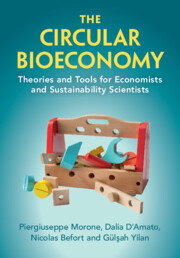Book contents
- The Circular Bioeconomy
- The Circular Bioeconomy
- Copyright page
- Contents
- Figures
- Tables
- Preface
- Acknowledgements
- Note on the Text
- Abbreviations and Notations
- Part I
- 1 The Historical Origins of the Bioeconomy
- 2 Emerging Bioeconomy Narratives
- 3 The Bioeconomy, the Green Economy, and the Circular Economy
- Part II
- Part III
- Index
- References
2 - Emerging Bioeconomy Narratives
from Part I
Published online by Cambridge University Press: 26 October 2023
- The Circular Bioeconomy
- The Circular Bioeconomy
- Copyright page
- Contents
- Figures
- Tables
- Preface
- Acknowledgements
- Note on the Text
- Abbreviations and Notations
- Part I
- 1 The Historical Origins of the Bioeconomy
- 2 Emerging Bioeconomy Narratives
- 3 The Bioeconomy, the Green Economy, and the Circular Economy
- Part II
- Part III
- Index
- References
Summary
The objective of this chapter is to offer a framework for understanding the debates around the bioeconomy. Indeed, a large body of literature has been developed in an attempt to identify the visions of the future and the narratives that aim to define the bioeconomy. This chapter offers a mapping of these visions and, based on three emblematic cases, shows how the three visions of the bioeconomy relate to economic realities.
Keywords
- Type
- Chapter
- Information
- The Circular BioeconomyTheories and Tools for Economists and Sustainability Scientists, pp. 15 - 30Publisher: Cambridge University PressPrint publication year: 2023

